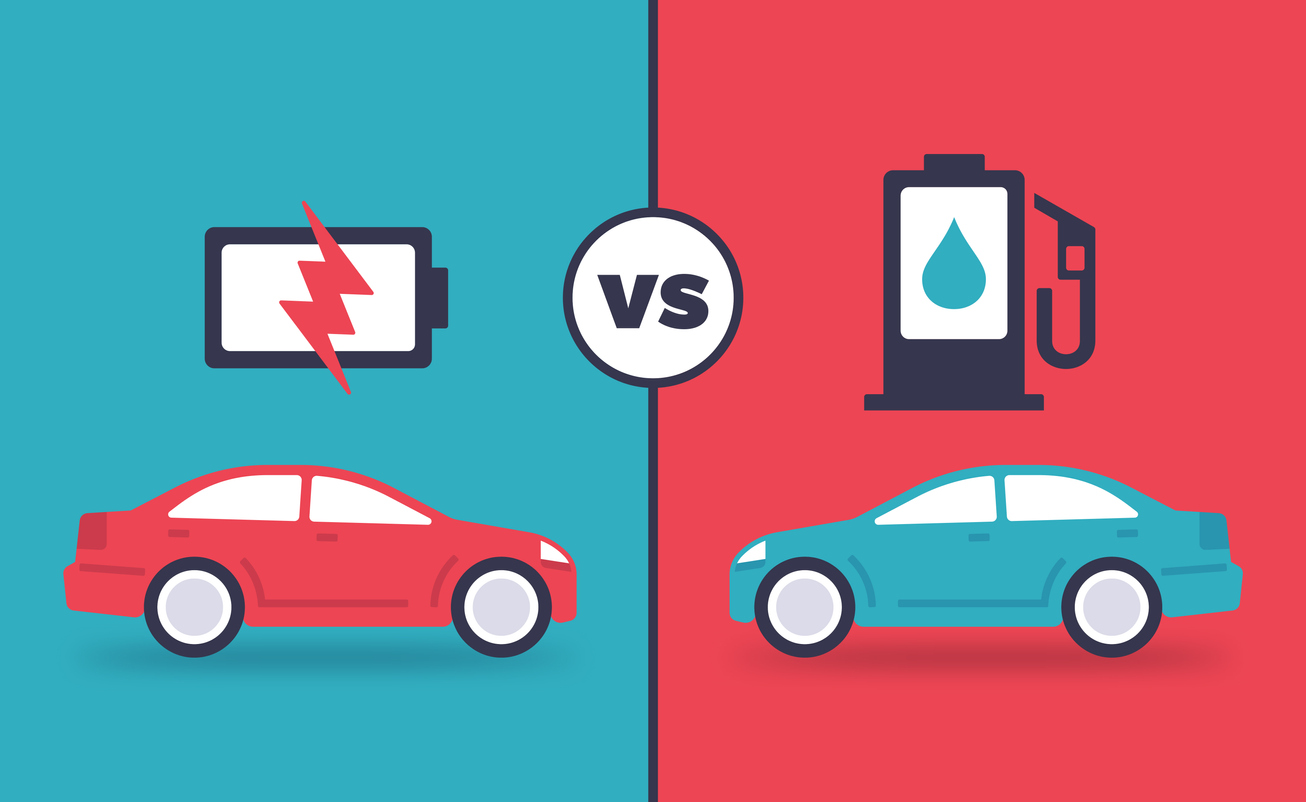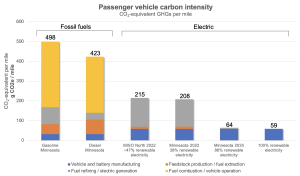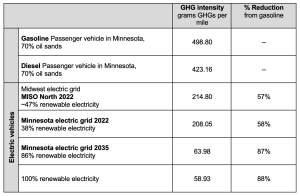Electric Vehicles Are Up to 88 Percent Less Greenhouse Gas-Intensive than Gasoline Vehicles
November 13, 2023 | Katelyn Bocklund and Dane McFarlane | Environment

In 2017, we published findings showing that electric vehicles provided significant greenhouse gas (GHG) reductions from conventional gasoline-powered cars in Minnesota. These GHG reductions will continue over the next decade as the electric grid further decarbonizes. This post explores an updated analysis using data from 2022, finding that electric vehicles continue to provide deep GHG cuts compared to conventional vehicles when charging on Minnesota’s electric grid.
Key takeaways from our analysis include the following:
- Electric vehicles are up to 88 percent less GHG-intensive than gasoline vehicles in Minnesota.
- An electric vehicle’s GHG intensity is highly dependent on the GHG intensity of the electric grid on which it charges.
- The electric grid is set to decarbonize over the coming decades, providing even greater GHG reductions from electric vehicles.
Electric vehicle greenhouse gas emissions now vs. then
In 2017, we reported that electric vehicles provided 65 percent GHG reductions in Xcel Energy’s Minnesota service territory and 53 percent in the Midcontinent Independent System Operator (MISO) North region (regional electric grid operator) compared to gasoline vehicles. When comparing the 2022 results to the 2017 results, there are two notable things to consider:
- Our 2017 analysis used Xcel Energy’s service territory as a proxy for the state, whereas our 2022 analysis factored in the entire state’s electric grid mix.
- The model we used expanded in scope, improved its data, and modified default inputs.
Between 2017 and 2022, the model’s estimate for upstream vehicle and battery manufacturing GHG intensity increased by 154 percent for gasoline and diesel vehicles and 188 percent for electric vehicles. These increases are likely due to updates, increased specificity, and expanded scope of the model rather than actual increases in GHG intensity.
Results
Results shown in the graph and table below indicate that while electric vehicles contribute more GHGs during the vehicle and battery manufacturing and electric generation phases, their lifetime GHG emissions are less than half of gasoline or diesel passenger vehicles driven in Minnesota.
The majority of GHGs emitted during an electric vehicle’s lifecycle comes from electric generation based on today’s electric grid. Charging on an electric grid primarily fed with renewable energy sources, however, greatly reduces GHG emissions.
This analysis highlights that an electric vehicle’s GHG intensity is highly dependent on the GHG intensity of the electric grid on which it charges. In Minnesota and other areas utilizing MISO North’s electric grid, electric vehicles offer considerable climate advantages over conventional vehicles.
These results serve as an important reminder that as we electrify transportation, we must inject more renewable energy sources into the electric grid to offer the most climate benefits.

Notes: Carbon intensity is measured in grams of carbon dioxide (CO2) equivalent per mile (CO2-equivalent GHGs per mile). MISO North’s electric grid has a lot of coal in states beyond Minnesota, which is why the carbon intensity difference between the two grids is small (3 percent) despite a 9 percent difference in renewable electricity. Sources: National Renewable Energy Laboratory’s (NREL) 2022 Cambium dataset, 2022 MISO North Fuel Mix

Sources: National Renewable Energy Laboratory’s (NREL) 2022 Cambium dataset, 2022 MISO North Fuel Mix
Methodology
Curious about how we conducted the analysis? Read on to learn about what we did and the sources we used.
The analysis first gathered real-time data of electric generation broken down by fuel source for the MISO North region. This region covers much of the Upper Midwest, including Minnesota’s electric grid. Primary fuel sources include coal, natural gas, and nuclear power, followed by wind and solar.
Next, data from the National Renewable Energy Laboratory’s (NREL) 2022 Cambium dataset, generated using NREL’s Regional Energy Deployment System (ReEDS) model, were used to better estimate the electric generation that serves the electricity consumption in Minnesota. ReEDS is an advanced model produced by NREL that provides both baseline historic electric generation and emissions, as well as projections for several future scenarios, for states and local districts. NREL’s estimate for Minnesota’s electric generation carbon intensity for 2022 was published in the ReEDS model’s Cambium dataset release.
Data for 2022 in the ReEDS model estimates that approximately 38 percent of Minnesota’s electric generation comes from carbon-free renewable energy and projects that 86 percent will come from renewable energy sources in 2035.
The rates of renewable versus fossil electricity generation from MISO North and NREL’s ReEDS model data for Minnesota were used as inputs into Argonne National Laboratory’s Greenhouse gases, Regulated Emissions, and Energy use in Technologies (GREET) model. The GREET model was used to compare GHG emissions from gasoline and diesel combustion with those associated with electricity generation.
As explained in our original analysis from 2016 and more recently by CBS Minnesota, conventional vehicles driven in Minnesota are primarily fueled by oil refined from Alberta oil sands—for this analysis, we assumed 70 percent.
After comparing fuel emissions, GREET’s vehicle-cycle model was used to compare the upstream GHG intensity of manufacturing and downstream GHG intensity of disposing and recycling vehicles and batteries for both conventional vehicles and electric vehicles.
Conclusion
Despite this change in estimated vehicle manufacturing emissions for both gasoline and electric vehicles, electric vehicles continue to provide steep GHG reductions compared to conventional vehicles. Depending on the percentage of renewable energy in the electric grid, electric vehicles are up to 88 percent less GHG-intensive. Given that Minnesota passed a law with the goal of achieving 100 percent carbon-free electricity by 2040, electric vehicles will continue to achieve significant GHG reductions.
About the authors
Dane McFarlane is the co-founder and lead strategist of Horizon Climate Group, which provides analysis, interactive tools, and easy-to-understand insights on energy, greenhouse gas emissions, and equitable climate solutions.
Katelyn Bocklund is senior program manager of the Transportation & Fuels program area at the Great Plains Institute. She also co-facilitates Drive Electric Minnesota.
